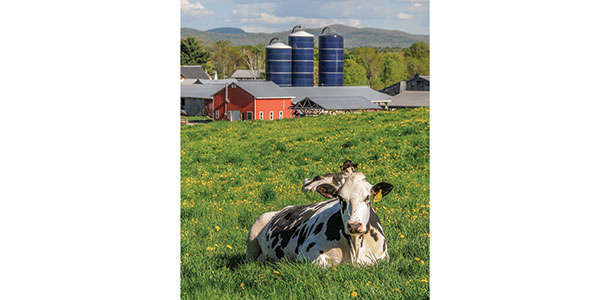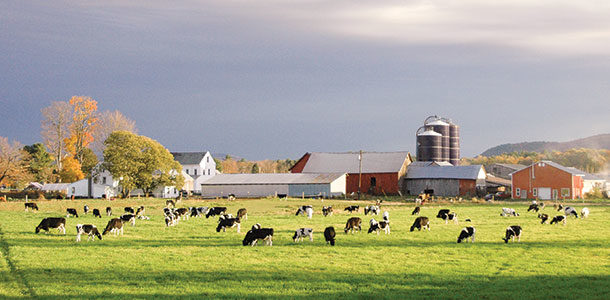For many dairy farmers, having milk cows that spend a good deal of their lives grazing on well-managed and productive pastures is an environmentally friendly and profitable way to dairy.
In regions with good soils and dependable water, high-quality pastures allow dairy farmers to optimize both feed tonnage and forage quality. Managed intensive grazing of dairy herds can result in improved milk revenue over feed cost margins.
Pastures provide forage, and forage is the foundation of dairy cow diets. The higher the quality of any forage, meaning the more of it that can be fermented and turned into energy in the rumen, the greater the value of the pasture and its contribution to a dairy’s profitability.
At the heart of getting the most out of pasturing dairy cows is the dairy farmer’s ability to optimize forage quality over the course of a growing season while not overgrazing and damaging pastures.
In most parts of the country, pasturing cows is seasonally limited – you can’t run cows out on pasture all year long. Even with managed intensive grazing, most dairy farms must still bring cows into a confinement environment for part of the year to keep them fed, healthy and productive.
Winter snows cover the ground in many regions, making grazing impossible. Where snow is not an issue, growth of grass still comes to a near standstill due to cold weather and shortened daylight hours, which is absolutely crucial to photosynthesis and plant growth.
Like any living organism, a plant’s singular biological purpose is to reproduce and propagate. Perennial pasture grasses and legumes go through a growth cycle with the most nutritional herbage – high in protein and low in fiber – being produced at the beginning of a season.
As forages grow and mature, their nutritional value declines as they lignify and flower or go to seed. In doing so, they spoil the party for livestock nutrition.
Milk production for dairy cows is primarily a function of feed intake, forage quality and balanced nutrition.
Two significant challenges for any dairy that grazes a herd is keeping the quality of the forage from degrading to a point where it’s no longer nutritional enough to produce a desired level of milk and also knowing how much dry matter and nutrition is coming from the pastures on any given day throughout the grazing season.
In Vernon, Vermont, Peter Miller and his family milk 150 cows and graze them on pasture for as much of the year as possible. The Millers transitioned from the conventional style of dairy farming with heavy grain supplementation several years ago and today have a certified organic herd, shipping milk to the Organic Valley Milk Cooperative.
The herd averages between 60 to 65 pounds of milk per cow per day year-round. During 2014, Miller says the herd grazed on pasture for 150 days. Miller knows exactly how much feed his cows consumed and how much of it came from grazing.
The average feed intake on a dry matter basis for the herd is 48 pounds. The pasture provided 34 percent of the dry matter – about 16 pounds of dry matter per cow per day – during the five months the cows grazed. This is feed that didn’t have to be chopped or baled or purchased from a feed mill.
The Miller herd is grazed on 90 acres of pasture located adjacent to the dairy facility. Milk cows are moved to a new paddock every 12 hours. The paddocks average 1.5 acres in size. After the milk cows are rotated off of a paddock, dry cows and heifers are put on that paddock to clean it up.
Then the paddock is clipped to get rid of any weeds and stems left behind. Pastures are watched closely for quality and content as they recover. As part of a managed intensive grazing program, cows are returned to the best paddocks when the grass is most ready.
Every year is different, says Miller, with some years producing much more grass than others. The quality of the pastures generally degrade later into the summer with the heat but then rebound during the fall. Throughout the grazing season, the herd’s diet must be adjusted to compensate for variations in the quality of pasture.

Miller shares that he’s still learning how to best manage pastures – when to fertilize, when to reseed and what types of grasses work best in his pastures. He says he avoids a monoculture of similar grasses, preferring a “salad” of different forage varieties to enhance the “pasture TMR.”
He likes the nitrogen-fixing legumes such as white and red clover and vetch. He likes bluegrass, perennial rye, meadow fescue and the hybrid festulolium. He likes dandelions and chicory because they absorb minerals and bust up the soil, and the cows really like them.
He doesn’t care for orchardgrass because it’s difficult to keep it high in protein. The cows don’t like tall fescue, and timothy doesn’t work for grazing, either.
While the Millers take full advantage of their pastures as much of the year as possible, they must still supplement their cows’ diets with grains and other harvested crops: corn silage and haylage.
In the spring of the year, when pastures are lush with young vegetation and the protein levels are high, Miller supplements the diet with about 12 pounds of corn meal and barley to meet starch requirements.
The diet is also supplemented with protein when necessary, depending on how pastures are holding up. During the winter months, the dairy becomes more “conventional,” with corn silage and haylage being fed with cows spending their days back in the freestalls.
All across the U.S., the decades-long trend has been to milk larger herds in confinement-style facilities in order to gain economies of scale that will stay ahead of shrinking profit margins.
In an effort to gain operating efficiencies that will support multiple families or hired labor, dairy farms find it much more cost-effective to pen the cows and bring the feed to them. On many large dairies, the only plot of grass to be found is a small pen reserved for sick cows. To a large degree, the art of pasturing and managed intensive grazing is becoming a lost art.
It’s no small undertaking to convert cropland to pastures and learn how to manage them to get the optimal feed production and quality off of them. The Miller family made the switch to pasturing both for economic reasons – for the survival of their dairy farm – as well as a belief that dairy farming should be done in as much of an environmentally sustainable manner as possible.
For the Millers, the successful transition to aggressive pasturing part of the year has been the right thing to do.
Pasturing and the managed intensive grazing of dairy herds isn’t for everyone. Climate, milk markets, economies of scale and lifestyle expectations all affect whether pasturing a dairy herd is feasible. Not every region of the country can make pasturing work. The decision to pasture milk cows should be made based upon sound financial reasoning as well as environmentally conscious factors.
Dairy products will continue to maintain their immense popularity and, for the foreseeable future, most of our nation’s dairy products will continue to be produced at large confinement-style dairy farms.
However, an increasingly environmentally and health-conscious consumer likes the idea of cows making milk from pastures. Dairy farmers who are willing to make the investment in pastures and manage them aggressively could very well be the ones who profit the most in a changing and challenging milk market. PD
PHOTOS
Cows on pasture at Peter Miller’s dairy in Vernon, Vermont, receive a “salad” of different forage varieties to enhance his “pasture TMR.”Photos courtesy of Paul Miller.

John Hibma
Nutritionist
Central Connecticut Co-operative Farms Association







